| Article ID | Journal | Published Year | Pages | File Type |
|---|---|---|---|---|
| 5999074 | Resuscitation | 2012 | 5 Pages |
BackgroundIntraosseous access is an essential method in emergency medicine when other forms of vascular access are unavailable and there is an urgent need for fluid or drug therapy. A number of publications have discussed the suitability of using intraosseous access for laboratory testing. We aimed to further evaluate this issue and to study the accuracy and precision of intraosseous measurements.MethodsFive healthy, anaesthetised pigs were instrumented with bilateral tibial intraosseous cannulae and an arterial catheter. Samples were collected hourly for 6Â h and analysed for blood gases, acid base status, haemoglobin and electrolytes using an I-Stat® point of care analyser.ResultsThere was no clinically relevant difference between results from left and right intraosseous sites. The variability of the intraosseous sample values, measured as the coefficient of variance (CV), was maximally 11%, and smaller than for the arterial sample values for all variables except SO2. For most variables, there seems to be some degree of systematic difference between intraosseous and arterial results. However, the direction of this difference seems to be predictable.ConclusionBased on our findings in this animal model, cartridge based point of care instruments appear suitable for the analysis of intraosseous samples. The agreement between intraosseous and arterial analysis seems to be good enough for the method to be clinically useful. The precision, quantified in terms of CV, is at least as good for intraosseous as for arterial analysis. There is no clinically important difference between samples from left and right tibia, indicating a good reproducibility.
